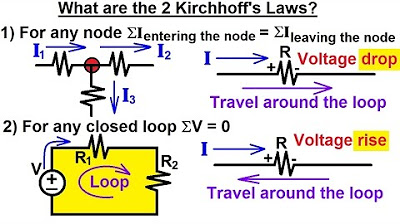Kirchhoff's Voltage Law - KVL Circuits, Loop Rule & Ohm's Law - Series Circuits, Physics
Summary
TLDRThis video explains Kirchhoff's Voltage Law (KVL), which states that the sum of voltages around a closed circuit must equal zero. It delves into the concepts of voltage, potential difference, and how energy is transferred through resistors and batteries. The video uses practical examples, showing how to calculate current and electric potential in a circuit with resistors and batteries. It emphasizes the importance of recognizing which components increase or decrease energy, providing viewers with essential tools for solving complex electrical circuit problems.
Takeaways
- 😀 Kirchhoff's Voltage Law (KVL) states that in a closed circuit, the sum of all voltages around the circuit must add up to zero.
- 😀 When determining voltages in a circuit, it is important to know whether the voltage will be positive or negative based on the energy flow in the circuit.
- 😀 Current always flows from high electric potential to low electric potential in resistors, resulting in a voltage drop (negative voltage).
- 😀 A resistor consumes energy, causing a voltage drop, and therefore, a negative voltage is assigned to it.
- 😀 In a battery, current can flow from low potential to high potential, meaning energy is being supplied to the charges and the voltage is positive.
- 😀 For resistors, always assign a negative voltage because they decrease the energy of the charges.
- 😀 For batteries, if current flows from low to high potential, the voltage is positive, indicating that the battery increases the energy of the circuit.
- 😀 KVL can be applied to calculate the current in a circuit by summing the voltage drops and solving for the current.
- 😀 The voltage at various points in a circuit can be calculated by determining the voltage drops across resistors using Ohm's law and summing the contributions from batteries.
- 😀 In a circuit with multiple batteries, the direction of the current depends on the total potential of the batteries, and batteries in the same direction add their voltages, while those in opposite directions subtract from the total voltage.
Q & A
What does Kirchhoff's Voltage Law (KVL) state?
-Kirchhoff's Voltage Law (KVL) states that the sum of the voltages around a closed circuit must add up to zero.
How do you determine the sign of voltage across a resistor?
-The voltage across a resistor is assigned a negative value because a resistor consumes energy, decreasing the energy per unit charge.
Why is the voltage across a battery positive when current flows from low to high potential?
-A battery increases the energy of the charges when current flows from low to high potential, so it is assigned a positive voltage.
How do the voltage drops across resistors and batteries differ?
-Resistors always create a voltage drop, which is negative, because they consume energy. Batteries can either increase or decrease the energy depending on the direction of current flow, with the voltage sign changing accordingly.
In a circuit with multiple components, how do you apply Kirchhoff's Voltage Law to calculate current?
-You sum all the voltage drops and gains around the circuit, set the equation equal to zero, and solve for the current using Ohm's law (V = IR).
What is the significance of assigning voltage values to each component in a circuit?
-Assigning voltage values to components helps track the energy changes at each point in the circuit and ensures that Kirchhoff's Voltage Law holds true, as the sum of voltages must equal zero.
How do you calculate the electric potential at various points in a circuit?
-To calculate electric potential at different points, you track the voltage drops or gains across components based on the direction of current and the resistance, using Ohm's law for resistors and considering the battery's voltage contribution.
Why is Kirchhoff’s Voltage Law important in solving circuit problems?
-KVL is crucial because it allows for the analysis of complex circuits by ensuring that the energy provided by sources equals the energy consumed by resistive components, helping to calculate currents and voltages throughout the circuit.
What is the role of current direction in determining the voltage sign across a battery?
-If current flows from low potential to high potential in a battery, the battery increases energy in the circuit, and the voltage is positive. If the current flows from high potential to low potential, the battery decreases energy, and the voltage is negative.
What happens when batteries in a circuit oppose or support each other?
-When batteries oppose each other, their voltages subtract, potentially reducing the current in the circuit. When they support each other, their voltages add, increasing the current in the circuit.
Outlines

Этот раздел доступен только подписчикам платных тарифов. Пожалуйста, перейдите на платный тариф для доступа.
Перейти на платный тарифMindmap

Этот раздел доступен только подписчикам платных тарифов. Пожалуйста, перейдите на платный тариф для доступа.
Перейти на платный тарифKeywords

Этот раздел доступен только подписчикам платных тарифов. Пожалуйста, перейдите на платный тариф для доступа.
Перейти на платный тарифHighlights

Этот раздел доступен только подписчикам платных тарифов. Пожалуйста, перейдите на платный тариф для доступа.
Перейти на платный тарифTranscripts

Этот раздел доступен только подписчикам платных тарифов. Пожалуйста, перейдите на платный тариф для доступа.
Перейти на платный тарифПосмотреть больше похожих видео

Electrical Engineering: Basic Laws (8 of 31) What Are Kirchhoff's Laws?

KVL and KCL (Circuits for Beginners #11)

Kirchhoff's Voltage Law (KVL) Explained

Kirchhoff's Voltage Law (KVL)

Kirchhoff's voltage law | Circuit analysis | Electrical engineering | Khan Academy

Kirchhoff's Voltage Law (KVL) - How to Solve Complicated Circuits | Basic Circuits | Electronics
5.0 / 5 (0 votes)
